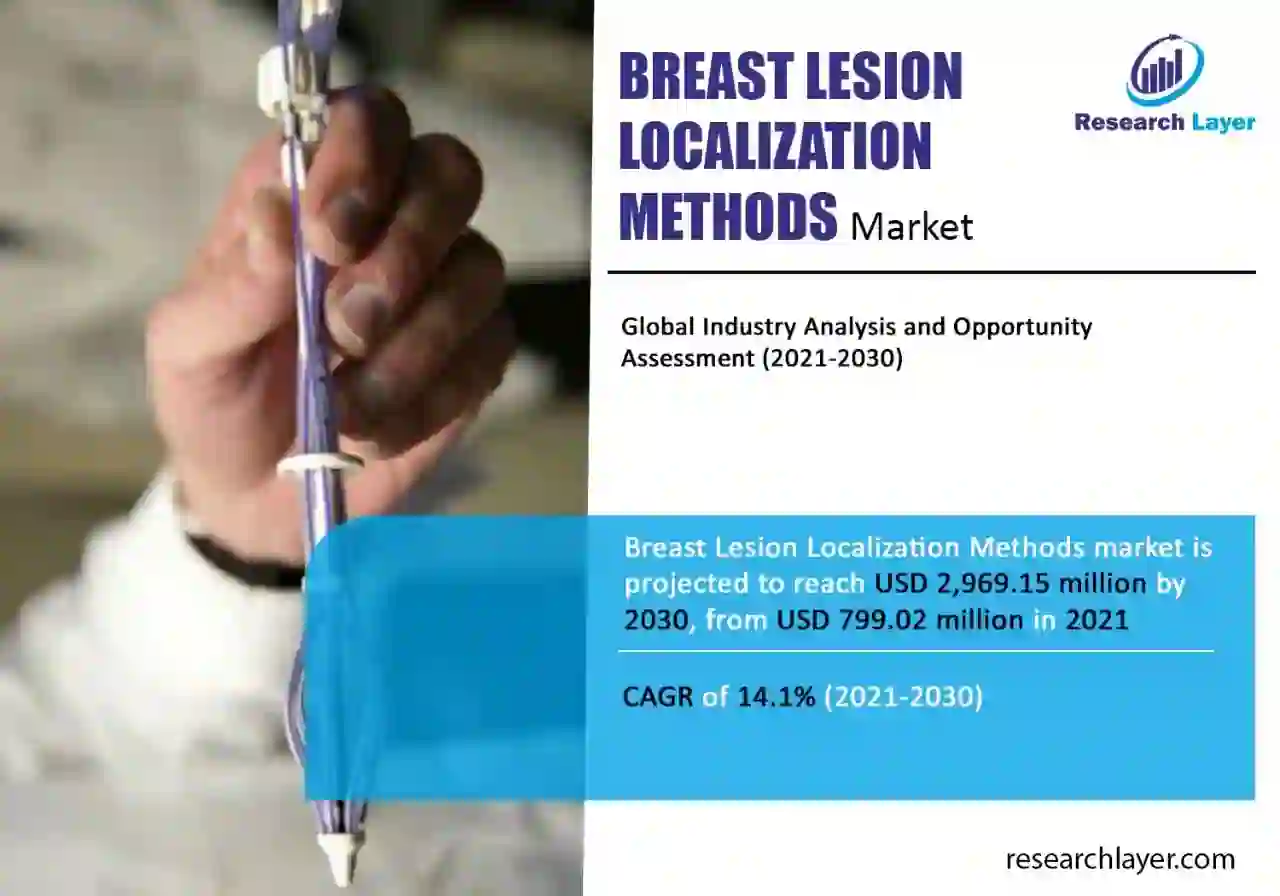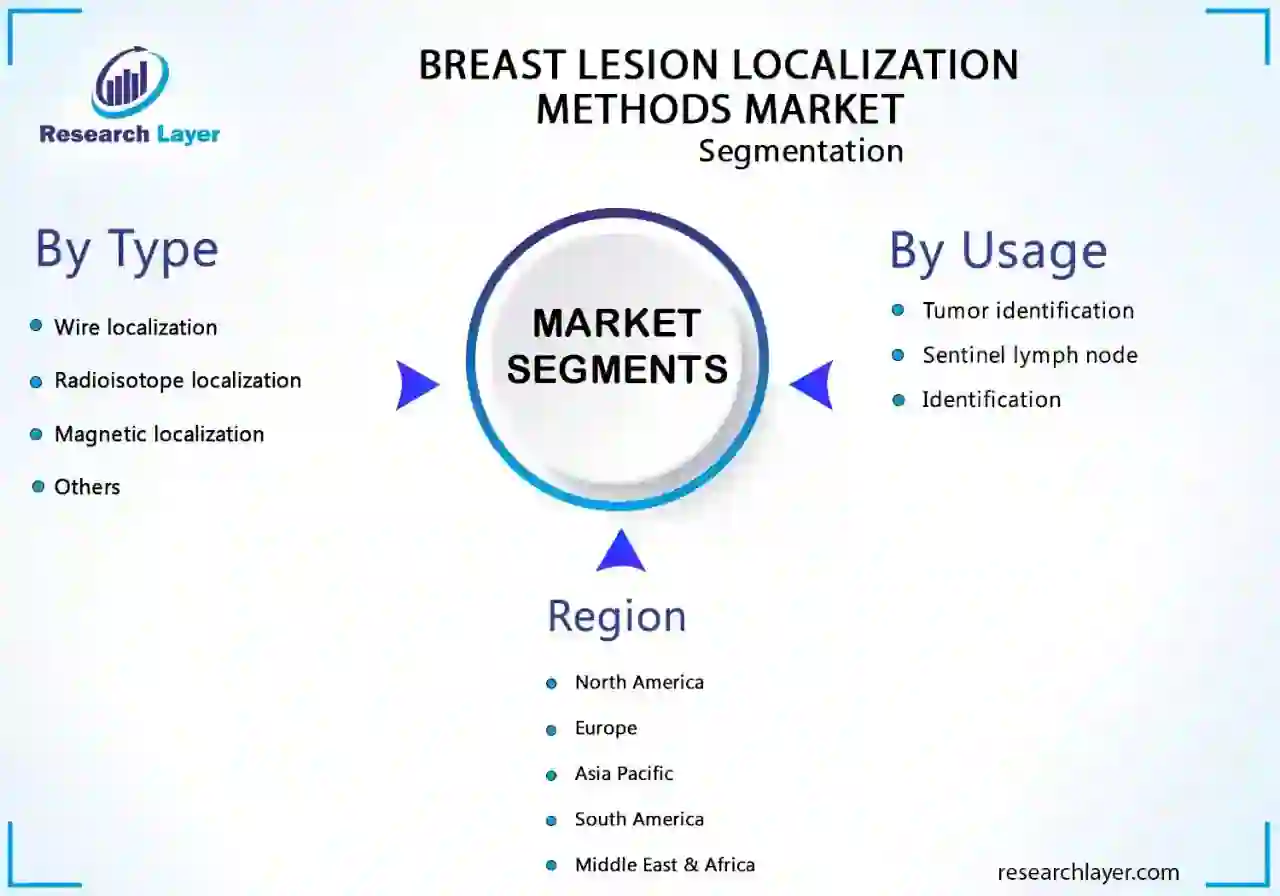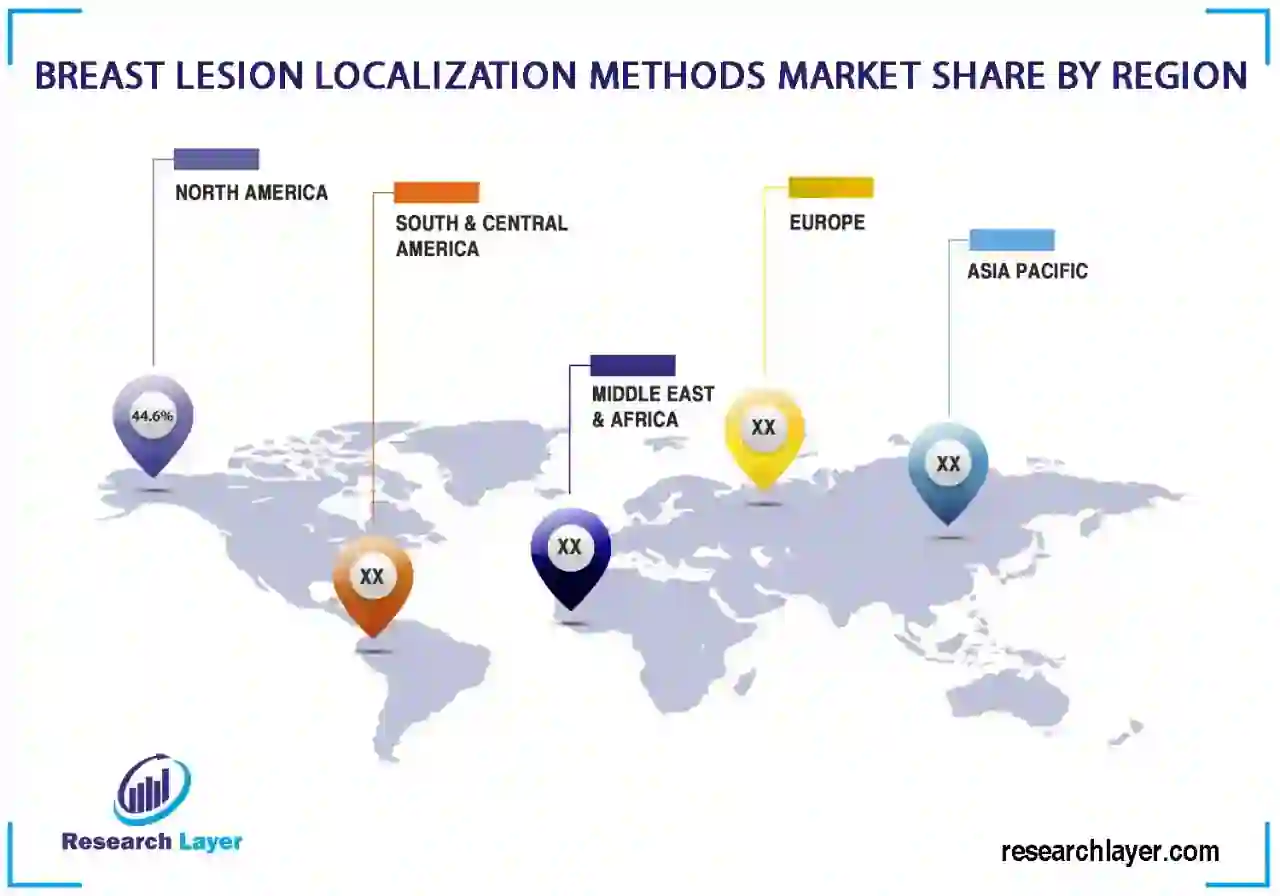 +1 915 229 3004 (U.S.) |
+1 915 229 3004 (U.S.) |  +44 7452 242832 (U.K.)
+44 7452 242832 (U.K.)
 +1 915 229 3004 (U.S.) |
+1 915 229 3004 (U.S.) |  +44 7452 242832 (U.K.)
+44 7452 242832 (U.K.)

The global breast lesion localization methods market is projected to reach USD 2,969.15 million by 2030, from USD 799.02 million in 2021, and is anticipated to register a CAGR of 14.1% between 2021 and 2030.


Download Free Report Sample to learn more about this report.
The breast lesion localization methods market is anticipated to expand at a respectable CAGR. MRI, ultrasound, and mammography are just a few of the many breast lesion localization techniques that are currently available on the global market. However, its adoption varies depending on the system's healthcare infrastructure. For instance, just 60% of people in Western nations have access to advanced detection technology compared to fewer than 5% in nations like China and India.
More than 60% of the world's population lives in Asia and the Pacific. More than 70,000 women die of breast cancer every year due to untreated disease, delayed diagnosis, a lack of access to adequate healthcare, and high treatment costs, among other factors. Despite making up only 5% of the world's population, the United States commands a large portion of this breast lesion localization methods market. However, the United States has the most expensive breast lesions and cancer diagnoses compared to other nations.
Due to rising urbanization, rising health insurance penetration, rising public and private hospital utilization, rising number of specialty hospitals, and decreasing cost of cancer diagnosis and treatment, emerging economies are anticipated to present market players with lucrative growth opportunities.
The global COVID pandemic has impacted almost every industry. However, it failed to undermine the cancer treatment sector. In the first two months of the pandemic, it has been noted that the number of outpatients, the frequency of doctor outpatient visits, the number of patients in wards, and the number of surgical procedures reduced by 80.3%, 50.0%, 70.6%, and 75.0%, respectively. The fear of contracting an infection, the rigorous lockdown, the lack of public transportation, and the ban on intercity travel, among other factors, were the leading causes of this. Accordingly, all hospitals have created comprehensive policies for safeguarding potentially susceptible cancer patients in various situations and have rescheduled non-urgent visits to reduce a given cancer patient's exposure to any medical environment.
On the other hand, cancer patients have complained about delays in getting the care they need, including follow-up clinic visits and cancer treatments, including radiation, infusion therapies, and surgical tumor excision. According to a recent prediction from the United Kingdom, breast mortality could rise by as much as 9.6% after five years if detection and treatment are delayed.


Download Free Report Sample to learn more about this report.
By Technology Type, The Wire Localization Segment Is The Largest Contributor In The Breast Lesion Localization Methods Market in 2020.
The dominance is owing to several factors. Some of the factors are, If an X-ray reveals multiple lesions, the surgeon can quickly locate and remove them all using wire localization to pinpoint the exact location of the lesions. The method of choice for removing tumors or lesions that are difficult to find or feel. It can also be utilized to remove the tiniest feasible region, which is difficult for a surgeon to do alone without clearly damaging the surrounding tissue. According to usage, we can categorize the breast lesion localization methods market into Sentinel Lymph Node and Tumor Identification
The tumor identification segment is the largest contributor in the breast lesion localization methods market Breast imaging, which mostly consists of mammography, a physical examination, and a biopsy, is all done to identify tumors. The majority of women who undergo it have breast tumors. X-rays are used during mammography to produce images of breast tissue containing tumors. In addition, other imaging methods, including MRI and ultrasound, are used. Women under the age of 30 are typically advised to have an ultrasound.
Drivers:
Increasing Prevalence of Breast Cancer
Each year, more than 2.3 million new instances of breast cancer are discovered worldwide. The prevalence is rising quickly. There are 285,000 cases in the United States and approximately 575,000 cases in Europe. The United States has the highest proportion of breast cancer patients, with fewer than 5% of the world's population. Lifestyle changes, an increase in the number of overweight people, obesity, delivery beyond 30, and a family history of breast cancer are the leading causes of the rising prevalence of breast cancer. People are less concerned with their physical welfare as a result of shifting market dynamics and the increasing penetration of IT firms.
A sedentary lifestyle is a further factor in support of this. Women are spending less time cooking now that more of them are working. They are discovered to be eating fast food and packaged foods that are high in calories as a result. Obesity is a result of a change in eating habits, which is one of the main reasons the incidence rate is rising. Additionally, breast cancer prevalence is fuelled by the rise in alcohol usage.
Rapidly Increasing penetration of Health Insurance
The high cost of cancer treatment is one of the primary factors hampering the market's growth. The price can vary from $10,000 to $200,000 on average, depending on the nation and its healthcare system. As a result, up until 2017, many citizens of the top developing countries, like India, China, Brazil, and Mexico, used their own money to make purchases.
The situation has changed, though. More people have started buying healthcare coverage. As a result, these nations offer the most affordable health insurance options in the world. Compared to less than 300 million in 2016, more than 500 million Indians have health insurance today. In addition, with the increasing working women population, most employers in India and China have started offering them free health insurance.
Additionally, the government of India has begun to provide insurance to everyone for up to $10,000 at a premium of less than $10 annually. The penetration of health insurance has increased as a result. As a result, more people are likely to approach oncologists as they don't have to worry about the cost of the treatment to some extent.
Breast Lesion Localization Methods Market Restraints:
Shortage of Skilled Oncologists and Limited Healthcare Infrastructure
In order for oncology to be able to diagnose, treat, and care for cancer patients, there must be a sufficient number of professionals working in the field, and they must keep an eye on these requirements as cancer cases rise. However, there need to be more qualified oncologists in the world market who can treat patients well. Even for wealthy nations like the United States, this is true. For instance, around 12,940 oncologists in the United States work in more than 1690 oncology practices nationwide. By 2021, there will be a shortage of at least 2,000 oncologists throughout the nation.
On the other hand, because of a lack of adequate healthcare infrastructure, only industrialized nations have access to advanced localization technology. For example, over 35% of the world's population resides in countries like China and India. However, these nations have fewer specialty hospitals than the United States. This shows a significant mismatch between supply and demand. In addition, most hospitals with oncology departments lack the tools and technology required for detecting and managing breast cancer.
Breast Lesion Localization Methods Market Opportunities:
Developing Economies to Offer Lucrative Growth Opportunity
For market players, developing nations like India, China, Brazil, Mexico, and Colombia present attractive opportunities. More people are relocating to cities with rapidly expanding urbanization in these countries. This has prompted both the public and private sectors to develop their healthcare systems. However, our research indicates that government hospitals lack the necessary technology. As a result, private hospitals are spending a significant amount of money on new equipment in order to draw in more patients and benefit from the current deficit in public healthcare.
Apart from this, these governments are also offering numerous incentives to establish new hospitals, such as cheap or free land, the incentive for each patient treatment, and subsidies on treatment costs, accessible credit facilities for buying needed machinery, among others. As a result, a huge number of private businesses are developing hospitals and expanding their network to establish brand and breast lesion localization methods market reach.


Download Free Report Sample to learn more about this report.
North America accounts for the significant market size at the time of prediction.
North America dominated for the breast lesion localization methods market. These dominance is owing to the several factors such as, the healthcare system is well-established in North America. Pharmaceutical companies and healthcare organizations are well-represented in the U.S. Additionally, the nation invests tens of billions of dollars annually to construct healthcare infrastructure. Additionally, the American government goes above and above to make healthcare accessible to all by providing payment and incentives for some treatments, particularly those for cancer.
More than 3.8 million women are living with breast cancer in the United States, and by the end of 2021, more than 281,500 new cases are anticipated. According to statistics, 13% of American women are estimated to have breast cancer at some point in their lives. More than 49,000 women receive non-invasive breast cancer diagnoses each year, according to the WHO. Compared to China and India, the country has a much greater prevalence of breast cancer. For instance, breast cancer is the primary cause of death for women and accounts for more than 30% of all malignancies in women that have been detected. Breast cancer claims the lives of more than 43,000 people annually.
Some of the major key player operating in the breast lesion localization methods market are SOMATEX Medical Technologies GmbH, BD., Merit Medical Systems., Endomagnetics Ltd, Cook, Intramedical Imaging, LLC, Ranfac Corp., Medtronic, Stryker, Wright Medical Group N.V., Zimmer Biomet., Smith+Nephew, Boston Scientific Corporation, Organogenesis Inc., Arthrex, Inc., Orthofix Medical Inc., Kubtec X-Ray, Miltenyi Biotec GMBH, Naviscan, PerkinElmer Inc., and Thermo Fisher Scientific, Inc. Among others.
The global Breast Lesion Localization Methods market is projected to reach USD 2,969.15 million by 2030, from USD 799.02 million in 2021 and is anticipated to register a CAGR of 14.1% between 2021 and 2030.
The Breast Lesion Localization Methods Market is studied from 2018 - 2030.
The Breast Lesion Localization Methods Market is growing at a CAGR of 14.1% between 2021 and 2030
North America holds highest share in Breast Lesion Localization Methods Market.
major key player operating in the Breast Lesion Localization Methods market are SOMATEX Medical Technologies GmbH, BD., Merit Medical Systems., Endomagnetics Ltd, Cook, Intramedical Imaging, LLC, Ranfac Corp., Medtronic, Stryker, Wright Medical Group N.V., Zimmer Biomet., Smith+Nephew, Boston Scientific Corporation, Organogenesis Inc., Arthrex, Inc., Orthofix Medical Inc., Kubtec X-Ray, Miltenyi Biotec GMBH, Naviscan, PerkinElmer Inc., and Thermo Fisher Scientific, Inc. Among others.


Report Code :
RL6521
Published on :
Nov 2022
Request a Free Sample Report